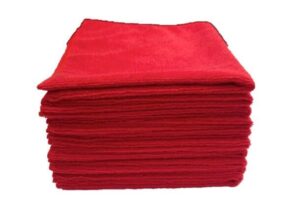 Microfiber is revolutionary.
Microfiber is revolutionary.
Sounds like hyperbole? Well, microfiber is worth such high praise. In recent years, more and more consumers (commercial and domestic) have discovered the myriad benefits of microfiber. For businesses, organizations, and families alike, this material has the power to create positive change.
In hospitals, salons, car-wash businesses, clinics, and other busy environments, microfiber is becoming a popular cleaning solution.
Here are five ways microfiber can change the world and make a lasting impact.
#1: Creating Safer Working Conditions
While it may surprise many people, janitorial staff face considerable risk at work. The dangers they may encounter include musculoskeletal injuries to the arms, neck, and back. 31 percent of all injuries sustained by janitors fall into this bracket.
Slipping on wet floors, sidewalks, or parking lots are to blame for such injuries. We have all seen janitorial staff mopping everywhere from the movie theater to hospitals, usually with a safety sign in place, and thought nothing of it. Yet excess water and a moment’s loss of concentration may lead to serious injury.
For less-experienced janitors, the danger is greater, with 54.9 percent of those injured between 2003 – 12 having worked in their role for a year or less.
When mopping floors with standard cotton-loop cleaning equipment, janitors generally use lots of water along with strong chemical detergents (more on this later), but microfiber provides a more effective clean with less risk.
This is because microfiber features thousands of fibers (much smaller than a single human hair), it can pick up more dirt and germs than alternative materials. With more surface area, they can absorb as much as seven or eight times their own weight in fluids.
As a result, less water is needed, creating a safer working environment for janitors and others around them.
#2: Saving Energy
Another benefit of microfiber? They are more eco-friendly due to their simple washing and drying process.
Microfiber cloths and microfiber towels should only be washed in cool water, as too high a temperature can affect the material’s performance. You should also avoid detergents, as these too can cause damage to the fibers’ adhesive qualities.
For businesses and organizations laundering their microfiber towels and cloths in bulk, less energy will be required overall thanks to this cool-wash cycle. When it comes to drying microfiber, it takes less time than cotton alternatives.
If you typically use a dryer, you will again use less energy, cultivating a more eco-friendly cleaning process.
Make sure the dryer is on the coolest setting to avoid damaging the microfiber. To take the environmental benefits further, you can air-dry microfiber faster than other materials, avoiding the need for electricity altogether.
#3: Reducing Water Wastage
Using microfiber mops, cloths, and towels will cut down on water wastage.
As we have already discussed, less water is required for cleaning floors using microfiber mops, as they retain more liquid and pick up more dirt particles than other materials. Bucket after bucket of water can easily go to waste while janitorial staff splash it across flooring, creating an unsafe environment for everyone.
This is true in the home, too, where wet kitchen floors pose similar dangers.
Considering the average family in the US gets through over 300 gallons of water everyday in the home, water usage needs to be reduced across the board. With less water required for cleaning with microfiber, and with shorter wash-times to launder them, businesses and organizations can make a big impact by switching to microfiber cleaning equipment.
#4: Encouraging Chemical-Free Cleaning
It’s incredibly common to use chemical-based products when cleaning. Mopping floors or wiping down work surfaces with detergents of various types is the norm in the workplace and home, yet these products can actually be harmful. Even those advertised as being ‘green’ can feature ingredients best avoided.
Not only can these cause irritation to the eyes or throat, they may well lead to health complaints. Volatile organic compounds (known as VOCs) have been known to contribute to chronic respiratory issues, headaches, and allergic reactions. Even bleach, which many of us use everyday, can cause potentially fatal problems when mixed with products containing ammonia.
As microfiber will clean surfaces without chemicals, using this can make for a safer environment and reduce the number of harmful gases released.
#5: Creating Less Waste Through Enhanced Durability
Microfiber contains thousands of fibers, which makes them stronger and more durable than alternative materials. As a result, they will withstand the rigors of everyday use better, staying strong and actually coping with more laundering. It is believed that the average microfiber cloth or towel can take more than 500 launders in a machine before it loses its effectiveness.
This durability means your budget for cleaning equipment will go further, and lead to fewer items going to landfill. It may appear to be a small difference, but if every business produced less waste and paid for more robust materials, the overall effect would be incredible.
Microfiber cloths and towels are a powerful aid to any home or workplace, leading to safer, faster, more efficient cleaning. With less call for potentially-harmful chemical-based products and reduced water costs, microfiber has the power to make significant changes around the world.

Comments are closed